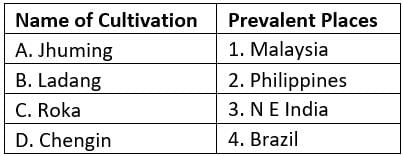Practice Test: World Geography - 1 - SSC CGL MCQ
24 Questions MCQ Test SSC CGL Tier 2 - Study Material, Online Tests, Previous Year - Practice Test: World Geography - 1
Which of the following conditions does NOT favor the development of true Karstic Topography:
Consider the following oceanic salts:
1) Sodium Chloride
2) Magnesium Chloride
3) Magnesium Sulphate
4) Calcium Sulphate
Q. Which of the following represents the decreasing order of their presence in oceanic waters:
Consider the following statements regarding the coral polyps:
1. Corals are found mainly in the tropical oceans and seas
2. Corals live in shallow waters of 200-300 feet depth.
3. Corals thrive in sediment free fresh water.
4. Corals grow well in lagoons and small enclosed sea.
5. Ocean currents and waves are favourable for corals.
6. There should be extensive submarine platforms for the formation of colonies by the coral polyps.
Q. Select the correct statement using the codes given below:
Which ecological pyramid does not give any idea of the rate of ecological/ecosystem production:
Which of the following countries are not part of Borneo Island?
Which of the following is/are associated with the equatorial region of the Amazon basin.
1. Bromeliads
2. Piranha
3. Manioc (Cassava)
4. Maloca
Q. Select the correct answer using the codes given below:
Which of the following are NOT correctly matched?
1. Young Fold Mountains - Alps
2. Old Fold Mountains - Sierra Nevada
3. Block mountains - Vosges
Q. Select the correct answer using the codes given below:
Consider the following statements regarding the Counter-equatorial Currents:
1. Counter-equatorial Current is less developed in the west due to stress of trade winds.
2. The Counter-equatorial Current carries relatively higher temperature and lower density than the two equatorial currents.
Q. Select the correct answer using the codes given below.
Consider the following statements regarding the various measures of atmospheric humidity:
1. Generally Absolute humidity does not change with increase or decrease of temperature, if no additional vapour is added through additional evaporation.
2. Specific humidity is affected by changes in air pressure or air temperature because it is measured in units of weight (grams)
Q. Select the correct answer using the codes given below.
Consider the following statements about the formation of Tropical Cyclones.
1. There should be continuous supply of abundant dry and cold airmass.
2. Higher value of Coriolis force is required for the origin of these cyclones.
3. They are associated with the inter-tropical convergence (ITC) which extends from 5-30 degrees N latitudes during summer season
Q. Select the correct answer using the code given below:
Which of the following regions have Mediterranean type of climate?
1. California (USA)
2. Western Australia
3. South-western South Africa
4. South Chile
5. South Australia
Q. Select the correct answer using the codes given below.
Consider the following statements regarding seismic waves during earthquake;
1. Love wave is the fastest surface wave producing entirely horizontal motion.
2. Rayleigh wave rolls along the ground and it moves the ground up and down.
Q. Select the correct answer using the codes given below.
Which of the following Great Lakes lie entirely in USA?
Which of the following pairs is not correctly matched?
With reference to Deccan traps, consider the following statements:
1. They are formed as the lava is highly fluid and rich in silica.
2. They affect extensive areas spreading out as thin sheets before they solidify.
Q. Select the correct answer using the codes given below.
Which of the following geographical phenomena have been aggravated by the climate change.
1. Tropical cyclones
2. Erosional activities
3. Spread of corals beyond tropics
4. Increase in sea salinity
Q. Select the correct answer from the codes given below
Consider the following statements regarding Van Allen radiation belts
1. These are a layer of charged particles held by any magnetized planetary body.
2. Satellites in the low earth orbit are subjected to intense radiation by them.
Q. Select the correct statement using the codes given below.
With reference to Dense fogs in winters, consider the following statements:
1. The dust particles which hold moisture are spread vertically
2. Dense fog is caused due to surface inversion
Q. Select the correct statement using the codes given below:
Consider the following statements regarding Subtropical latitudes:
1. They are under the influence of trade wind in summers and westerlies in winter.
2. They experience hot and dry summers.
3. They experience severe and rainy winters.
Q. Select the correct statement/s using the codes given below:
Consider the following statements regarding the Continental Shelf.
1. Continental Shelf typically ends at very steep slope, called the shelf break.
2. Continental Shelf is the deepest region of the oceans.
3. Siberian continental shelf in Arctic Ocean is the largest one in the world.
Q. Select the correct statement/s using the code given below:
Match the following sets of pairs:

Q. Select the correct answer from the codes given below:
Consider the following statement/s regarding soil:
1. Humid climates in high latitude coniferous forests, mid – latitude tropical forests to low tropical forests and grasslands have Pedalfers type of Soil.
2. The arid, semi – arid and sub – humid zones in the world have Podcals group of soils.
3. Podcals are deficient in calcium and mineral salts while Pedalfers are calcium rich.
Q. Select the correct statement/s using the code given below:
Swathi, at local noon time looks down on the ground and sees her extended shadow in the Northern direction. Which of the below cities is Swathi definitely located?
Consider the following features of a climate:
1. It is experienced along the eastern coasts of tropical lands.
2. It's region receives steady rainfall due to Trade winds.
3. Rainfall is both orographic as well as conventional due to intense heating.
Q. Select the climatic region which has above mentioned characteristics.
|
1366 videos|1313 docs|1016 tests
|
|
1366 videos|1313 docs|1016 tests
|


















